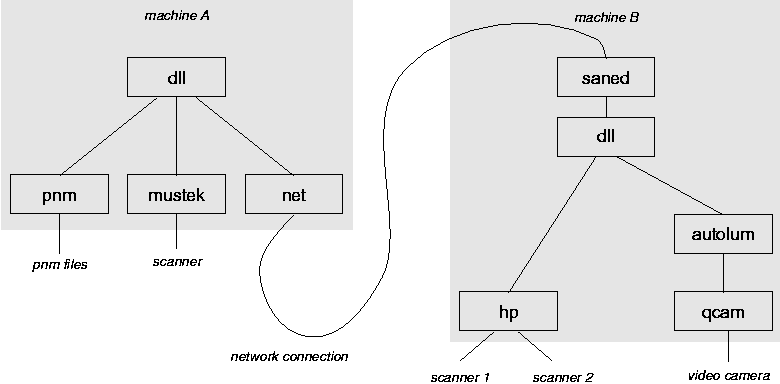
When building a SANE application, it must be linked against the shared library called libsane.so. In reality, libsane.so is just a symlink to one of the SANE drivers. Since every SANE driver exports the exact same interface, you can change the libsane.so symlink at any time and effectively change which driver the application is using. While this is useful in the sense that it allows upgrading to a different driver without having to relink all the applications, it would not be very convenient if you had to change a symlink whenever you wished to switch the scanning device. For this reason, SANE supports two pseudo-drivers called dll and net. They are pseudo-drivers because rather than talking to physical devices, they talk to other SANE drivers, as illustrated in Figure 6.
For machine A, the libsane.so symlink points to the dll pseudo-driver (called libsane-dll.so). That pseudo-driver uses dynamically linked libraries (dll) to access other SANE drivers. In the example, dll is configured to use the pnm, mustek and net drivers. The net driver is again a pseudo-driver; it provides access to remote scanners by connecting to the SANE daemon (saned) running on machine B. Machine B in turn uses dll again to provide access to a variety of other drivers. As you might imagine, the exact configuration is entirely up to the system administrator(s) of machines A and B. It is fairly typical to have libsane.so be a symlink to the dll pseudo-driver, but there is no reason it couldn't point to the net pseudo-driver or just the mustek driver. Of course, in the latter case the implication would be that applications could access the mustek driver only---but that's perfectly reasonable for certain environments.

This approach is very flexible, but it raises an interesting question: how do we name devices in such an environment? The answer is that every real driver has its own device name space. For example, the Mustek and HP drivers use the path for the Unix special device that controls the device, such as /dev/scanner. With pseudo-drivers, things get a bit more interesting. Since dll must guarantee that each device name is unique, it simply prefixes the name of each subordinate device with the name of the subordinate driver, separated by a colon. Thus, on machine A, the mustek scanner would be called mustek:/dev/scanner. The net pseudo-driver does something similar: it prefixes the remote device name with the remote host name (again using a colon as a separator). For example, HP scanner 1 on machine B would appear on machine A under the name net:B.domain.com:hp:/dev/scanner1. While this doesn't make for the world's prettiest names, the information contained in the names is actually quite useful. In essence, much like a Unix path name, the device names convey the path through the SANE hierarchy that leads to a particular device. For example, if you know that machine B is down, it's pretty obvious that net:B.domain.com:hp:/dev/scanner1 will be down as well. If someone feels strongly about these names, it is possible for an application to let a user or system administrator define aliases that are more concise. For example, an application could let a user rename the above device to ``HP Scanner 1'', which may be easier for beginners.